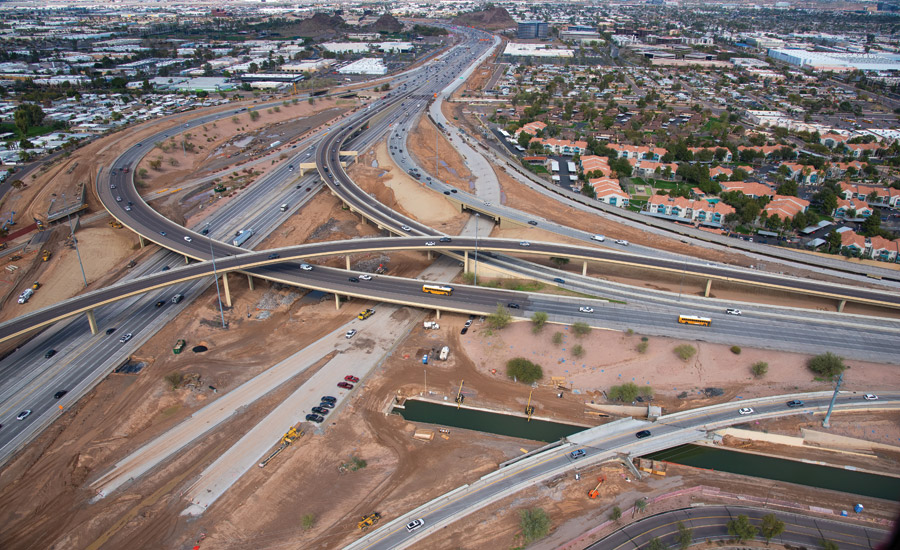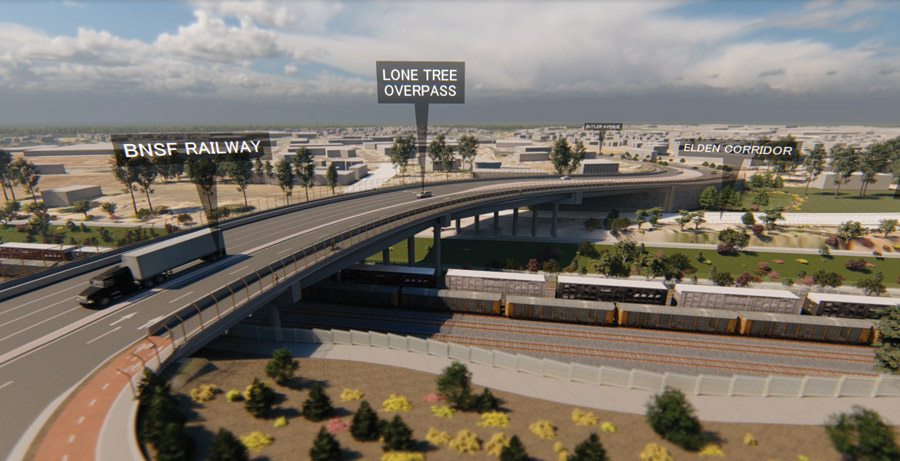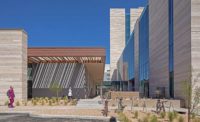Related Link:
ENR Southwest Top Design Firms 2024
If WSP USA’s regional revenue trend is any indication, the Southwest’s design and construction market appears to have regained what momentum it may have lost during the pandemic years. After more than tripling its previous year’s performance by reporting $176.7 million in 2022 revenue for Arizona, Nevada and New Mexico, WSP enjoyed another boost in ENR Southwest’s most recent design firms survey, with 2023 regional revenue rising to $184.7 million.
Sustained revenue growth in a strong market wasn’t the only factor contributing to WSP’s selection as ENR’s Southwest Design Firm of the Year. WSP finished at or near the top of nearly every market and geographic sector, making the most of what senior vice president Arpit Talati says is an abundance of opportunity.
“Southwest states continue to see exponential growth and significant expansions in infrastructure, health care, tech, start-ups and movement of goods,” says Talati, who serves as the firm’s Texas-Southwest district lead. “Energy, in particular, is a rapidly growing sector in the region, with large wind and solar energy projects and natural gas pipelines.”
Other key projects for WSP in the region include design of the 45,000-sq-ft Children’s Hospital Medical Office Building in Phoenix and serving as owner’s representative for the city of Santa Fe, N.M., as it implements its Midtown Redevelopment Program.
“Clients are trying to get projects ready but don’t always understand the landscape of all those new federal grants.”
—Matt Sibul, Southwest Transportation Lead, WSP USA
Understandably, there’s plenty of competition among design firms for these opportunities. What helps set WSP apart, says Matt Sibul, the firm’s Southwest transportation lead, is the ability to draw on a broad, nationwide pool of technical expertise.
“Regardless of what issue or problem we’re trying to solve for a client, it’s really appealing to have that depth and breadth of talent across our company,” Sibul says.
That’s particularly true for the mining sector, which has delivered a significant portion of WSP’s regional revenue over the past two years. With mining playing an important role in the global transition to green energy, explains WSP senior vice president Jim Daly, the firm is helping mining companies not only develop new reserves and meet growing demand for critical minerals, but it is also helping firms meet environmental, social and government (ESG) commitments.
At BHP’s copper mine in Globe, Ariz., for example, WSP is providing construction management services to improve the stabilization of a historic tailings embankment while eliminating the potential for future dam slope failure-related risks from natural disasters. WSP is developing the report outlining activities involved with the closure of the Nacimiento copper mine in northern New Mexico, ensuring compliance with regulatory requirements and environmental standards.
Daly adds that WSP is applying a variety of innovative technologies to support clients across a mine’s full life cycle.
“We’re utilizing drones for mapping and sampling activities to keep workers out of harm’s way,” he says. “New storage methods for innovative mine tailings storage methods help reduce mine site water consumption.”

WSP is the general engineering consultant for the $700-million I-10 Broadway Curve Improvement P3 project in Phoenix.
Photo courtesy Arizona Dept. of Transportation
A Region on the Move
Transportation, another key sector for WSP, is being driven by both regional population growth and new funding resources via the Bipartisan Infrastructure Law. Sibul says clients are asking for more than just traditional planning and design services. For example, WSP is being asked to provide engineering and environmental studies for the Arizona Dept. of Transportation’s proposal to refine the existing Sonoran Corridor/SR 410 into a 400-ft freeway alignment and assisting the New Mexico Dept. of Transportation in addressing pavement “heaving” along a 118-mile-long segment of U.S. Route 550.
“Clients are trying to get projects ready, but don’t always understand the landscape of all those new federal grants,” Sibul explains. “Because we have an advisory group that understands what’s available, we act as a matchmaker of sorts to find the best grants for a particular project.”
In another example, WSP recently helped ADOT secure a $24-million grant for a complex system of wildlife crossings along an 8.4-mile corridor of I-17 south of Flagstaff. The grant is the second-largest award in the first $110-million round of funding from the Federal Highway Administration’s Wildlife Crossings Pilot Program, announced last December.
“WSP worked very closely with oil and gas industry stakeholders from the earliest stages.”
—Michael Smelker, Assistant District 2 Engineer, New Mexico DOT
Sibul adds that transportation projects increasingly overlap with other infrastructure considerations. The firm is overseeing the Nevada Dept. of Transportation’s Middle Mile Program, which includes design and permitting of 1,000 miles of broadband infrastructure for the entirety of Interstate 80 in Nevada.
Also, the planned build-out of recharging stations for electric vehicles is putting DOTs in the position of being “energy integrators,” Sibul adds.
“DOTs are trying to get smarter on those topics to push some of this transformation,” he says. “But while the programs are growing, their internal resources are not. They’re increasingly looking to consultants to serve as an extension of their staff to keep projects and programs moving.”
Michael Smelker, assistant District 2 engineer with the New Mexico DOT, is one state transportation official appreciative of WSP’s contributions to a recent project, the NM 31/128 Reconstruction Project in the Permian Basin.
“WSP worked very closely with oil and gas industry stakeholders from the earliest stages of the project. They completed a study that showed the projected industry hot spots in the future,” Smelker says.
For example, “roundabouts developed for two intersections included provisions to accommodate oversized vehicles more than 276 ft long. The modern roundabout design represents an innovative solution that prioritizes the corridor’s safety, efficiency and operational needs,” he says.
Similarly appreciative of the firm’s work is Grey Byers, Arizona DOT state engineer, who commented: “I have had the pleasure of working with WSP on several projects during my tenure. I have always been impressed with their responsive nature when it comes to the simple things such as just returning a phone call to the more complex problem-solving recommendations.”

WSP provided full design services for the city of Flagstaff's $87-million Lone Tree Overpass, scheduled for completion by 2027.
Rendering courtesy WSP in the U.S.
Coping with Uncertainty
With continued growth comes the challenge of making the most of the region’s limited water resources. That formidable task is epitomized by the ongoing battle to slow depletion of the 250,000-sq-mile Colorado River Basin, which is being pressured by both demand and climate change.
WSP is already active in this area, aiding New Mexico’s Office of the State Engineer to investigate, conserve, protect and develop water resources and stream systems statewide and carry out plans and programs for beneficial uses of water. At the other extreme, Sibul says transportation designs are incorporating resiliency measures for major storm events—a more frequent occurrence in the region.
“Once rare 100-year floods are happening more often, which means we need to rethink things like culvert designs and detention and retention basins,” Sibul says. He notes that WSP is also looking upstream for ways in which it can help clients take a holistic approach to their building and infrastructure. One example is Future Ready, WSP’s firmwide innovation program that aims to assess how society’s needs will change in step with technology, climate and other drivers.
“It helps us as an industry to have those conversations,” he says, “and it helps the community think more comprehensively about how we design our built environment to make it better going forward.”
That’s why, Talati says, it’s critical for WSP to forge even stronger relationships with the region’s top engineering schools to identify and recruit rising talent and ensure that they have opportunities once they arrive to sustain the company’s expertise in these areas as well as in those areas that may take on an even greater importance in the future.
“That has always distinguished us as a company,” he says, “and we want to be positioned to continue partnering with public agencies and private developers to keep up with infrastructure, engineering and energy demands for years to come.”





Post a comment to this article
Report Abusive Comment